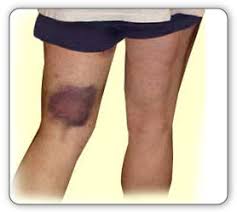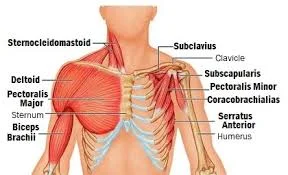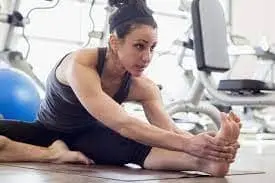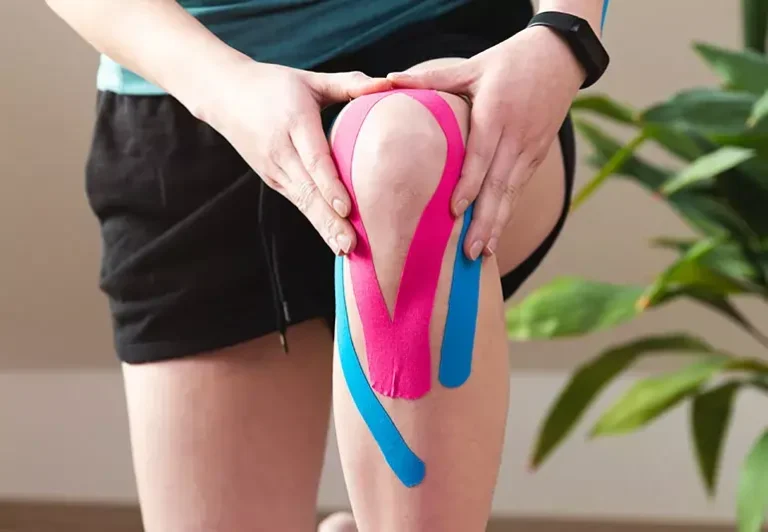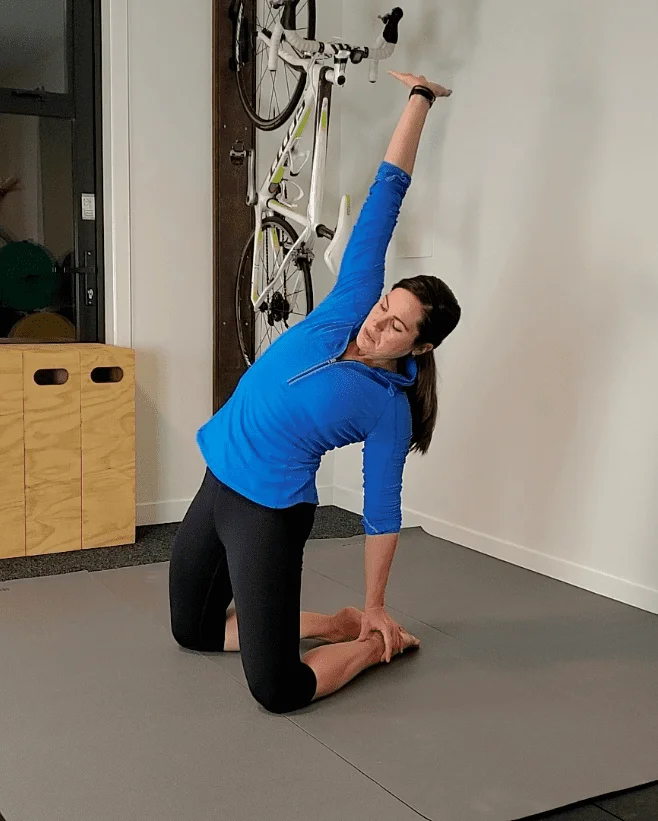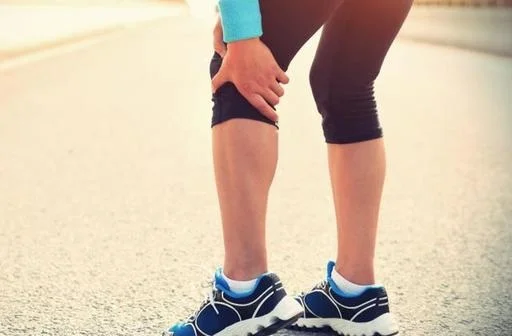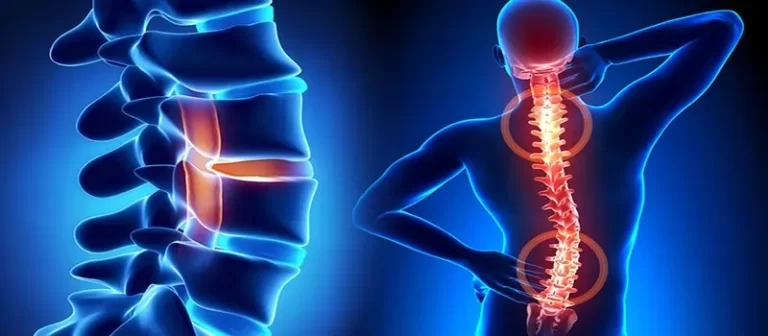Bruises for Hamstring Injury
Introduction
The Bruises from a hamstring injury, which affects the muscles in the back of the leg, can be insufferable and immobilized. Bruising is one of the most typical indications and symptoms of a hamstring injury. Bruising, sometimes referred to as a hematoma or contusion, is caused by bleeding beneath the skin from broken blood vessels.
The bruises injury to the hamstrings can cause instant pain and perhaps even bruises. The bruise usually shows up as a darkening of the skin over the wounded area, which changes color as it heals, from dark purple or blue to yellow or green. The bruising suggests that the blood vessels throughout the body have been damaged without the muscle or encompassing tissue who are aware of the connection between hamstring injuries and bruises are better able to identify and treat their symptoms. Prompt detection and suitable intervention are essential for achieving the best possible outcome and averting additional issues.
A bruise for hamstring injury occurs when one of the three muscles that run along the back of the thigh, the hamstrings, are strained or pulled.
Those who participate in sports that require them to sprint with quick endings and begin frequently have hamstring problems.
Tennis, basketball, football, and soccer are a few examples. Both runners and dancers may get hamstring strains. A rip in the hamstring muscle fibers is called a pulled hamstring or hamstring strain. The back of the thigh, from the lower pelvis to the back of the shin bone, is home to a collection of massive, strong muscles called the hamstrings.
The hip joint is extended and the hamstring muscles bend the knee joint. For hamstring injuries, self-care techniques like rest, ice, and pain medication are frequently sufficient to reduce swelling and discomfort. Surgery to restore a hamstring tendon or muscle is an uncommon procedure. The majority of therapies are done at home. Depending on the period of the injury, rehab must take a few days or several months
This article will examine the relationship between bruising and hamstring injuries in greater detail. It will also look at the many kinds of hamstring injuries, their causes, and how to treat and prevent them.
The anatomy and mechanism of a Bruised Hamstring
The hamstring muscles’ major muscular portion comprises bundles of thousands of muscle cells. Fascia, the white, sinewy substance found in meat, is a thin layer that holds these bundles together. These bundles are abundant in a single muscle. The muscle itself is also covered in a layer of fascia. The fascial layer is penetrated by blood vessels. The blood arteries split until small enough to provide each cell with nutrition and oxygen.
Cause of Bruises for Hamstring injury
There are several routes that hamstring injuries can occur, but overstretching is the most typical one. Additional explanations are as follows:
- Unfortunately, as we age, our tendon and muscle tissue begins to deteriorate, increasing the likelihood of any accident. Increased movement and stretching/strength training can lessen this.
- exhaustion from excessive training.
- a strike to your thigh straight.
- Not heated up enough.
- The program for preconditioning is inadequate.
- prior hamstring strain
Intramuscular and Intermuscular Contusions
An intramuscular contusion results when there is tissue damage, or tearing, within the muscle but not within the fascia, or the muscle’s sheath. When both the muscle and the fascia are ripped, the condition is called an intermuscular contusion. Visible bruises might not appear if the contusion is intramuscular since the bleeding is contained within the muscle sheath. However, the bleeding causes an increase in muscular pressure, which can hurt and make movement difficult.
When there is an intermuscular contusion, a bruise is typically seen when blood seeps through the ripped fascia. An intermuscular contusion usually heals more quickly than an intramuscular one because blood and other fluids do not accumulate inside the muscle, which can lead to edema and occluded blood vessels.
Grades of intramuscular and intermuscular contusion
Grade 1: Mild Strain
sensitivity where the injury is
slight edema, if present
Muscle tenseness in the calves
Potential challenges when walking, but minimal impact on range of motion
Grade 2 Moderate contusion
stumbling and swelling
Pain during exercise and while applying pressure to the injured area Restricted range of motion
unable to extend as far as typical
stiffness and pain after exercising, especially in the morning
Grade 3 Severe Contusion
severe discomfort at the scene of the accident that persisted for a few days
Unexpected and obvious edema
bruises and swelling that could reach the calf and knee
tense muscles
The hamstring muscles are weak.
It is impossible to walk without help or crutches.
unable to sleep because of pain
Signs of Bruises for Hamstring injury
Knowing the most typical symptoms of a hamstring strain will help you make sure to receive medical attention as soon as possible to stop the issue from growing worse. These are the most typical indicators to watch out for.
- Sharp Hamstring Muscle Pain: Acute, sharp pain in the back of the leg or beneath the buttocks, close to the muscle attachment, is usually present with hamstring tears. There is frequently a “popping” or “snapping” sound at the site of the injury before this discomfort.
- Tenderness: To the touch, the affected area may feel tender. Pain may be felt while applying light pressure on the hamstring muscles.
- Bruising and swelling: Since hamstring tears result in serious tissue injury, it’s not surprising that the majority of patients also have some bruising and swelling. After an injury, swelling may show up within a few hours, but bruising may take many days to manifest. There may be bruises near the hamstring muscles if the tension is very bad. Bruising is a sign of tissue injury or internal hemorrhage.
- Leg weakness: When you walk, run, squat, or bend, your hamstrings control how your hips and knees move. When performing any of these exercises, the majority of persons with hamstring tears report feeling weak in their legs.
- Limited Range of Motion: The affected leg’s range of motion may be lessened. It could be tough for you to bend the leg at the knee or fully stretch it.
- Difficulties supporting weight: Hamstring tears can cause difficulty or even impossibleness supporting weight on the leg in addition to weakness when moving or bending the leg. Many people say that when they try to put weight on their leg, it feels as though it will give way or buckle. Bearing weight can also be quite painful.
- Loud Sound: A pulled hamstring occasionally produces an audible “pop” sound at the scene of the injury. This may be a sign of a more serious muscle breakdown or strain.
Symptoms of bruises for hamstring injury
The degree of the injury determines the hamstring pull’s symptoms. An acute hamstring strain is typically excruciating. The degree of damage to the muscle and tendon fibers characterizes a strain.
The severity of hamstring injuries is rated on a scale from 1 to 3. Depending on the degree, you could have a variety of symptoms, but often, hamstring discomfort, edema, and weakening are present.
Fibers with a grade 1 strain are stretched but not ripped.
A partial tear of some of the muscle or tendon fibers results in a grade 2 strain.
When a muscle or tendon completely tears or ruptures, it is referred to as a grade 3 strain.
Strains in the muscles can happen gradually due to overuse injuries or suddenly as a result of a particular injury. Furthermore, if intense activity is tried before the muscle has completely healed, a hamstring pull may get worse. Tenderness, soreness, and swelling are signs of muscle or tendon strains, which also induce inflammation at the site of the injury. There may also be muscle spasms. A hamstring injury may result in bruising at the site of injury since muscles have an excellent blood supply. Following an accident, blood may seep downhill as gravity pulls it in that direction, resulting in bruises that may be seen in the calf or behind the knee.
Grade 1: A grade 1 strain of the hamstring must be felt as a little pull or pain in the back of the thigh. The actual injury might not be memorized or recognized, and the start of the pain may be incremental. There might be minor swelling and nonspecific pain when the knee is expanded. A limp must or must not be present, but the pain is generally deepened with aggressive exercise like running or walking up or downstairs.
Grade 2: Grade 2 strains frequently happen with an acute circumstance, and a quick sharp pain is felt in the back of the thigh or higher up toward the buttock. Walking might be hard because expanding the knee stretches the injured muscle, and a limp is usually present. Swelling and tenderness should be valued in the region of injury.
Grade 3: Symptoms of a grade 3 strain are an advancement of a grade 2 strain with symptoms of pain and swelling being more noticeable. Numerous times in muscular injuries, the muscle must be so aggressively stretched that it tears with a popping sound so noisy that it should be listened to by other players in the area. If there is a considerable tear, a convexity can sometimes be felt in the belly of the muscle at the region of injury
With grade 2 and 3 injuries, it must take a few months to regain on the lower end, but as numerous as 6 months for the most intense bruises injuries.
Muscle strains and tears most normally happen due to what is named an eccentric contraction. When an eccentric contraction of the muscle happens, the muscle is attempting to contract while another force the ground, another player, etc.) is thrusting the muscle in a contrasting direction. This creates tremendous bruises on the muscle, and if the power is strong enough, it would tear the muscle fibers.
Other common symptoms include:
- Bruising: Small tears without the muscle cause bleeding and next bruising. The bruise initiates in the back of the thigh, and as time expires the bruise will pass down below the knee and frequently into the foot.
- Swelling: The accumulation of blood from the hamstring injury generates swelling of the thigh. This should make further muscle contraction difficult and painful. Wearing a compressive bandage should help maintain the swelling.
- Muscle spasm: Muscle spasm is a standard and painful symptom of hamstring harm. Because of the trauma to the muscle, signals of contraction are tensed, and the muscle may be stimulated. If intense, muscle relaxants should aid with spasms.
- Muscle contraction difficulty: After a torn hamstring, bending the knee can be unpleasant and may even make it impossible to walk properly. It may indicate that the hamstring is completely ruptured if you are unable to contract it.
If there is extensive bruising if the injury is very near to the knee or buttock:
It should mean that the hamstring is torn loose from the bone.
Most likely, a sports medicine or orthopedic physician will be referred to you.
To rebuild the hamstring tendon, you should have surgery
Diagnosis of the Bruises for Hamstring Injury
A physical examination and history are used to diagnose hamstring bruising. The type of injury will be derived from the circumstances of the incident, and a physical examination will assess the degree of muscle or tendon damage. The medical expert may inquire about the specifics of the ailment to assess the mechanism of injury and review any attempts at home remedies. A prior medical history may also be significant since arthritis or injuries to the knee, hip, or back can reduce muscle flexibility and range of motion, making the hamstring more vulnerable to damage.
A physical examination frequently involves palpating the muscle to determine its level of soreness and edema. A divot or flaw that can be felt along the muscle’s length indicates a grade 2 or 3 tear, which supports the diagnosis. Tests of the back, hip, and knee range of motion can be performed both with and without resistance in an effort to reveal pain that may not always be felt by palpation.
The patient will frequently be placed flat on their stomach and have their knee bent to a 90-degree angle by the doctor. This may lessen muscle spasms by relaxing the hamstring muscles. At that point, the hamstring muscles can be touched, and a possible flaw is recognized. The physical examination will help to distinguish between a pulled hamstring and pain from bones or joints. Other possible origins of pain may be taken into consideration. Sciatica can also resemble a hamstring strain. Sciatica is a pain that comes from the nerves as they exit the spinal canal in the lower back.
Most people don’t require additional tests. X-rays may be recommended if there is a possibility that the pain is caused by an avulsion fracture or another injury to the knee, femur, or pelvis. While most patients do not require magnetic resonance imaging (MRI), it can be used to assess the severity of muscle and tendon damage. MRI scanning can be utilized by elite athletes to help schedule their recovery, rehabilitation, and competitive return.
Treatment for Bruises for Hamstring injury
Immobilization: Your physician might advise you to use a temporary knee splint. Your leg will heal more quickly if you maintain this neutral posture.
RICE stands for rest, ice, compression, and elevation. This is the initial treatment for strains. This is also how a pulled hamstring is managed. It could also be advised to alternate between heat and ice.
Principle of rice
Rest: Walking may be challenging since each stride causes the hamstring to stretch as the knee extends or straightens. It might be essential to take it easy and refrain from doing any weight-bearing exercises for a while. Crutches can be used as a temporary mobility aid.
Ice: Icing should be done periodically for 15-20 minutes at a time. The ice is positioned on the region of injury and pain. The skin must be covered from direct contact with the ice to prevent frostbite.
Compression: One technique for compression is to use an ice wrap. It is common practice to apply one or two 6-inch wraps, starting at the knee and going around the leg until the wrap reaches the hip and groin. Not too tight to be painful, but just stiff enough to feel the compression. To help athletes go back to practice and competition faster, athletes are frequently taped to give the same compression and support.
Elevation: Another useful technique for reducing swelling is to raise the wounded leg above the level of the heart. This promotes quicker healing by promoting fluid drainage away from the site of injury. When you are at rest, try to keep your leg raised.
Inflammation-reducing drugs like ibuprofen (Advil, Motrin, Nuprin) may help manage the pain associated with inflammation. These medications could, however, have negative consequences, like a higher chance of bleeding and ulceration. Unless specifically instructed otherwise by your doctor, they should only be used temporarily. Despite being over-the-counter drugs, there could be interactions between them and prescription drugs, or there can be underlying medical conditions that make using anti-inflammatory drugs illegal. Before taking any medications, it is advisable to consult a pharmacist or healthcare provider.
A pulled hamstring should gradually heal and resume normal function over a few weeks in cases of grade 1 or 2, requiring no additional therapy.
In rare instances, grade 3 strains requiring substantial muscle and tendon damage may need to be repaired surgically. Should a sizable bone avulsion fragment be detected, it could need to be reattached. There are three stages to a strain’s healing. The first stage reduces the pulled muscle’s inflammation, the second restores the blood supply, and the third starts the muscle’s remodeling and repair so that it can resume its full range of motion.
The body creates scar tissue to heal itself whenever a muscle is ruptured. The region might not heal fully for four to six weeks. In addition to resumed activities, full range of motion restoration and strength of hamstring muscle at home or with a therapist may need to be considered. The hamstrings run the danger of suffering another injury, experiencing persistent pain, and weakening if they are unable to regain full function.
Physical therapy may be used to improve the range of motion, start light stretching, and resume activities of the pulled muscle following a five-to-seven-day course of RICE treatment. Blood circulation can be improved and the healing process started with the use of electrical stimulation therapy and muscle ultrasonography. After two to three weeks, muscular strengthening and more stretching may be necessary.
Light stretches and workouts
Not only can skipping too much exercise cause scar tissue to build around the rip in your hamstring muscles, but skipping too much activity might make your injury worse.
When the soreness starts to go after a few days, that’s when you should start exercising gentle hamstring stretches to prevent this.
A workout of mild training, like walking and cycling, and hamstring strengthening exercises must come next.
For a proper fitness routine, the general physician can offer you more advice and, if needed, recommend you to a physiotherapist.
You should only resume full-range activity when your hamstring muscles are sufficiently strong to prevent further injury. You can get advice on this from your general practitioner or physiotherapist.
Many people must take a few weeks off from sports, but the exact amount of time off depends on how serious your injury is.
Gradually introduce more strenuous activities. Don’t attempt to run a 5K in a few days after initiating to walk.
Don’t go overboard. When you are exhausted, control, don’t push it aside. Your muscles are more powerless to injury when you strain them to the limit. Strength and flexibility exercises should be beneficial in bruises for hamstring injury
Half squats

The hamstrings, gluteus, and quadriceps were the major muscles utilized.
After this training, your back, thighs, and front should feel quite good.
Tools required: You can hold hand weights to gradually increase the resistance as the activity gets easier to complete. Work your way up to 10 lb. weights by starting with 5 lb. weights to raise the resistance level.
4-5 sessions, each consisting of 10 repetitions,
Detailed instructions: Put your feet apart and stand with your shoulders wide apart. You can either stretch your arm in front of you or place your hands on the front of your thighs. Use a wall or chair’s back as a balance point if necessary. Keep your chest up while dropping your hips gradually by about 10 inches to create the impression of a chair.
Maintain a five-second hold while keeping your weight firmly on your heels.
Raise your body back up to a standing position by using your heels.
Resist from bending forward from the waist as a tip.
Curls of hamstrings standing
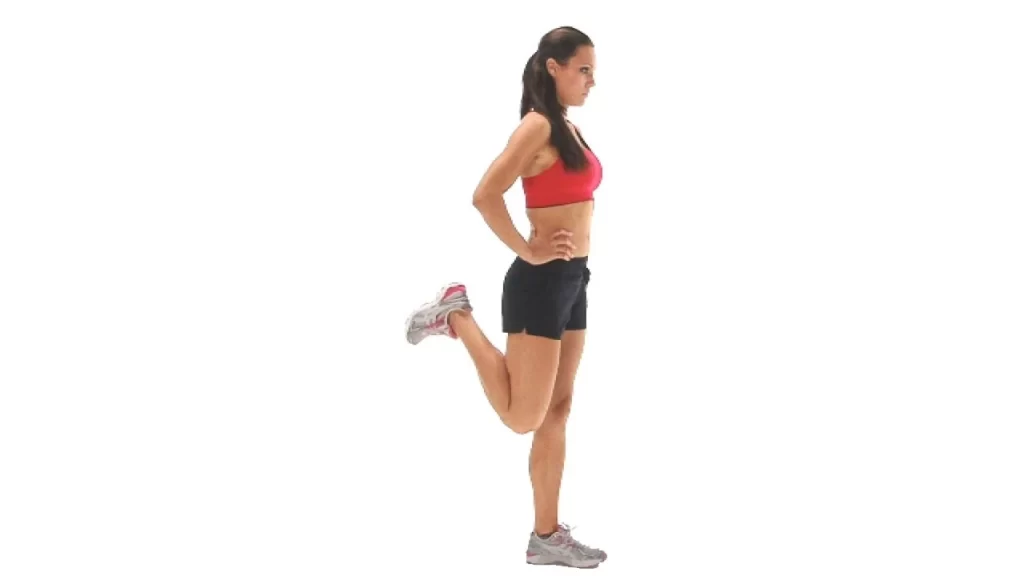
The muscles concerned are the hamstring (back of the leg) and gluteal (buttock).
How to act: Standing upright, your knees should solely be divided by one or two inches. Grasp onto the countertop, a strong chair, or something different for balance.
Slowly bend one knee behind the body while keeping the thighs aligned and lifting the heel off the floor. Raise the heel easily until the knee reaches a ninety-degree angle. Maintain a slight bend in the straight leg to avoid locking.
Carefully drop the bent leg to the ground after five seconds of elevation.
Repeat twice more with the same leg.
Switch sides and continue.
How not to behave: stop from pointing your toes up or flexing your foot. give grant the foot to remain in a level, neutral position.
Hamstring curls on a weight bench
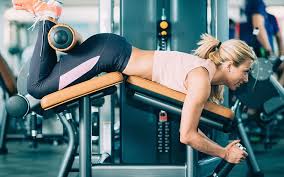
The muscles involved are the gluteal and hamstrings.
This exercise is a modified variation of the standing hamstring curl. This variation can be tried by anyone who has access to a weight bench made especially for this exercise. This exercise may be more challenging than the standing hamstring curl, depending on the amount of weight utilized.
How to act: Put your legs together and your face down on the bench. Hold onto the handles for support.
Put the feet under the weight. The point of weight is instantly above the heels.
Slowly bend both knees while using your legs to propel the weight upward. As soon as the knees bend to a ninety-degree angle, gradually increase the weight.
Raise the weight for 8 seconds, then progressively decrease it back down to complete up to 12 repetitions. Perform two workouts a day, three times a week.
How not to behave: When you first attempt this exercise, don’t use a heavyweight. Beginners should begin with the lightest weight and work their way up to heavier ones as they build strength.
Deadlifting dumbbell
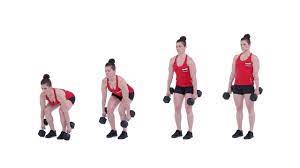
How to behave: Spread your feet shoulder-width apart and point your toes slightly outward. Keep your body straight, your gaze forward, and your shoulders back during the entire exercise.
While keeping your weight on the front of your body, tighten your core and rotate your hips backward, as if you were tapping your butt against the wall behind you.
As you lower yourself toward the floor, shift your weight along the front of your tibia bone while keeping your back level. Continue until your hamstrings start to feel tight and/or your spine starts to round. Lastly, tighten your glutes to propel your hips forward. One rep is involved.
Perform ten repetitions in three sets.
Note: In addition to not grasping any weight, you can execute deadlifting exercises using a kettlebell, dumbbell, or barbell bar.
Sumo Squat
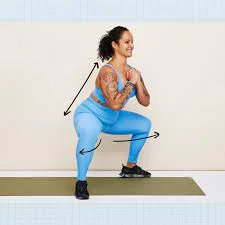
Why it works: If you want to enhance a particular muscle area, like your hamstrings, you need to dedicate training time to the surrounding muscles to avoid muscular imbalance. The sumo squat is essential for strengthening your inner thighs, which are located near your hamstrings.
Step into a standing stance with your toes pointed out and your hands by your sides, folded in front of your chest or held out in front of your body.
The individual should maintain an elevated, neutral back and chest, tense the abdominal muscles, and shift the weight into his or her heels. To lower oneself into a squat, he or she should extend their arms in front, push their hips back, and bend their knees.
Push through the soles of your feet to stand, then contract your glutes once. Do ten repetitions.
session: two or three times
Muscles involved: pectineus, gracilis, gluteus, adductor longus, adductor brevis, adductor Magnus, hamstring, quadriceps, and calves
Hamstring Curls in prone

Method: Start on a mat in the prone posture, which is on your stomach. Make sure the anchor or resistance point is away from your body when you fasten a band resistance or cable cuff around one ankle. Set your feet apart by hip width. Engage your core and abdominal muscles gently (sometimes referred to as “bracing”) to stiffen your body and stabilize your spine. Keep your ankle slightly dorsiflexed throughout the exercise, pointing your toes in the direction of your shinbone.
Curling Movement: Raise your hips off the mat or curve your lower back by bending or curling your knee after exhaling. Don’t move your thigh; instead, keep your heel close to your buttock. Continue bending your knee until you are as comfortable as possible or until your heels touch your buttocks. When you begin to feel movement in your lower back or hips, you know that your joints have reached their limit.
Movement Downward: Inhale deeply and gradually lift your leg back to the starting position.
Exercise Improvement: To strengthen this workout, you can put your heel closer to your buttocks to increase resistance in the cable or band or your range of motion.
The lower back arch is raised during this exercise since there is usually a tendency to stretch the lower back or push the hips forward. By using your abdominal muscles, you can help prevent hip hiking and low back hyperextension.
Standing and bending forward
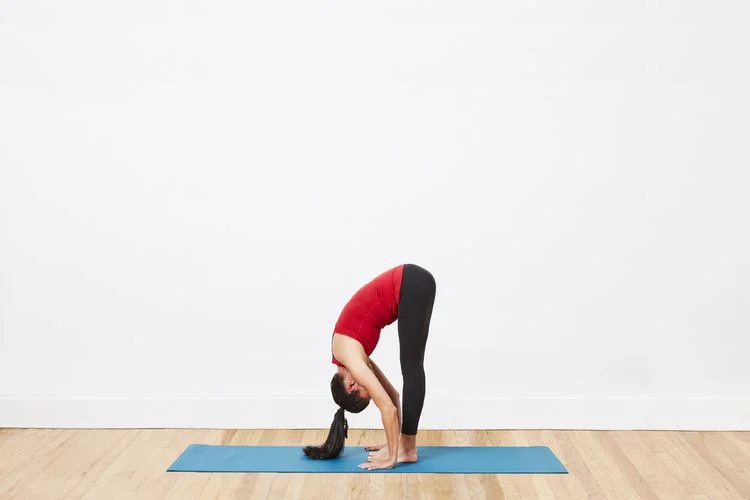
To tone the hamstrings at the back of the thighs, perform a standing hamstring stretch. You can reduce knee pain, loosen up tight muscles, and increase flexibility by performing the standing hamstring stretch.
How to do it: Keep your posture straight while standing behind an exercise step or yoga block.
Plant your heel on the step while keeping your right leg raised and your toes pointed upward. Straighten your right knee.
Bend toward your right leg, raise your arms straight up, and curve from the hips.
Feel your right hamstring stretch as you hold this position for 20 to 30 seconds.
Flip the sides to the left.
On either side, repeat 2-4 times.
Toe-touching when standing
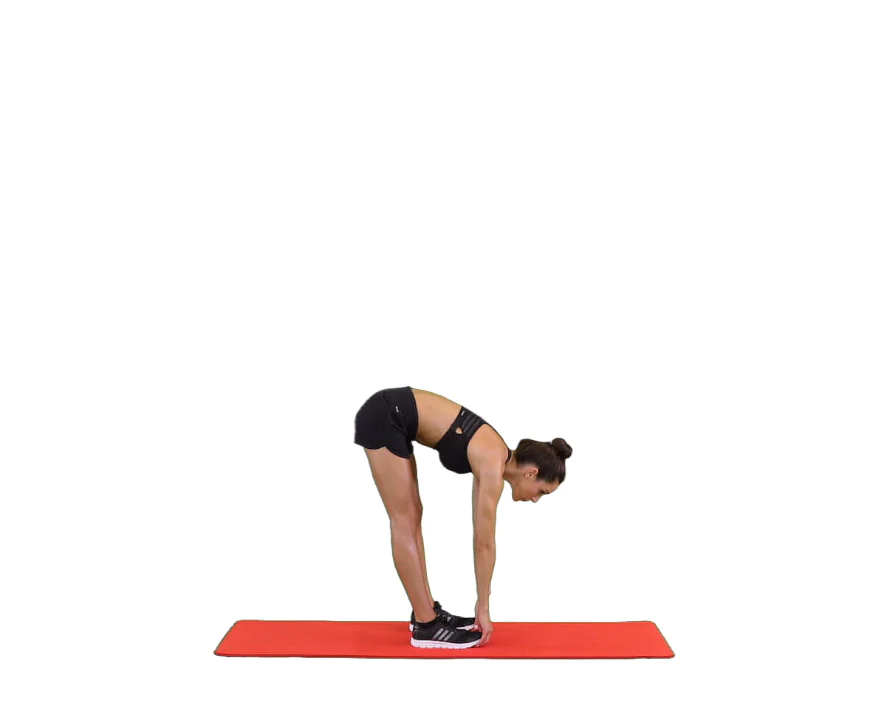
Maintaining a neutral back position during the standing toe reach exercise can help you stretch your hamstrings and calves.
To execute the toe reach while standing: Maintain a posture of ease and place your feet hip-width apart.
Slide your arms down your thighs and shins, toward your feet, while repositioning your hips slightly back.
Lower yourself to the point of slight discomfort while maintaining a straight back.
Keep the posture for half a minute.
As part of your stretching routine, perform the stretch three times
Barbell deadlift
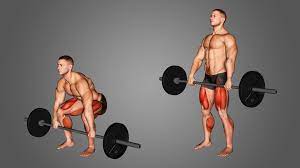
You have access to the strongest compound exercise because it can raise the most weight: the deadlift. That should be your strongest lift, no mistake about it.
The deadlift, which will greatly improve your upper and lower body strength and muscular bulk, is one of our favorite barbell workouts. While the main focus is on the quadriceps, glutes, hamstrings, and back, this is a full-body posterior chain workout. Naturally, grip strength and bone strength are developed as a result of having to hold onto the barbell. Similar to squats, deadlifts will also increase anabolic hormones. Furthermore, deadlifts create neurological strength changes that translate to more difficult upper and lower body exercises like barbell bench presses and squats. The better your deadlift is, the stronger all of your lifts will be. It is the most potent booster available.
If you are unable to execute deadlifts for whatever reason (lower back pain when deadlifting is common; this is a high-risk, high-reward sort of training), there are alternatives to deadlifting that you should consider.
Steps to conduct: To start, place your feet shoulder-width separated beneath the bar. If not contacting the bar, your shins should be in contact with it.
Stretch back at the waist and press your buttocks to reach the bar on either side of your legs.
Using both hands, take an overhand grip on it.
Hip jerk
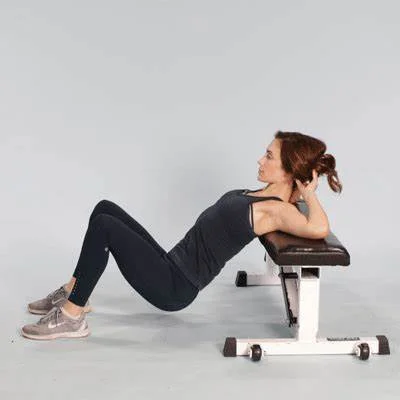
Why it functions: The hip thrust exercises the glutes, but it also tones the hamstrings. To activate your hamstring muscles more, take an extra step with your feet out.
Position yourself on the floor with your feet slightly wider than hip-width apart, your knees bent, and your center of shoulder blades resting against a bench or box. Hold a medium- or heavy-weight dumbbell in place with both hands in the hip crease.
Maintaining a flat lower back, tucked-in chin, and forward gaze, contract glutes, drive through heels, and extend hips to return to the beginning position while raising the dumbbell to the ceiling. The body should create a straight line from the shoulders to the knees, with the knees bent at a 90-degree angle in line with the heels.
Lower your hips gradually until your butt is only a few inches off the ground while maintaining a level lower back and solid knees. Next, extend your hips and push through your heels to gradually elevate the dumbbell; be careful to perform this exercise with your hamstrings and glutes instead of your back.
To get back to the starting position, keep raising your hips until your body forms a straight line from your shoulders to your knees. That amounts to one rep.
Kettlebell Swing
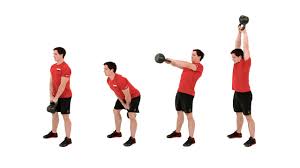
Why it works: When performing a kettlebell swing properly, your lower body and core should be doing the majority of the effort. This includes your hamstrings, which tighten as you bend back and forth to raise the kettlebell into the air.
How to execute: place a kettlebell on the floor approximately one foot in front of your toes, and stand with your feet shoulder-width apart, and your hands at your sides. To droop your arms toward the floor, slightly bend your knees and pivot at the hips. With both hands, grab the kettlebell handle and tilt it toward your body.
pull the kettlebell back and up between your thighs while taking a breath. Then, exhale, drive through your hips, engage your glutes, and press your feet into the floor to stand up fast and swing the kettlebell rapidly forward to chest height. Throughout the exercise, maintain your arms extended with your elbows slightly bent, and let your eyes follow the kettlebell.
Drive the kettlebell back down and between your thighs while bending your knees lightly and flex at the hips. That amounts to one rep.
Elongated gluteal bridge
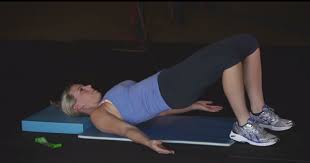
Why it works: A standard glute bridge works, well, your glutes. It functions similarly to the hip thrust. You can make your hamstrings work harder by extending your feet a little bit further.
How to appear: With your knees bent, feet flat and hip-width apart, and your arms at your sides with your hands facing down, lie face up on the floor. Step out on each foot one step at a time to ensure that your toes are pointed 45 degrees upward and your heels are pressing into the earth.
To raise your hips off the ground, exhale, press through both heels slowly, and maintain a tight tailbone. As high as you can raise your hips without letting your lower back arch is the goal.
Breathe in and slowly return your hips to the floor, one vertebra at a time. one rep is it
At-home cures
Recall the abbreviation R.I.C.E., which stands for elevation, compression, rest, and ice.
till the soreness goes away, stop what you’re doing, or at least cut down on what you’re doing.
After your injury, spread ice to the region for 24 to 48 hours. After 15 minutes of maintaining the ice on, clear it and repeat the process.
make utilize of an elastic thigh sleeve or compression wrap. Wear it whenever you don’t have a shower or ice.
To hold your range of motion flexibly, utilize mild exercises.
With your damaged leg drooping off, sit on a table. When your leg is chilling off, slightly elevate it and drop it. Once your leg has iced, lie on your stomach in a prone posture and keep gently bending and straightening it.
Use over-the-counter medications, such as tablets, gels, and/or creams.
If walking is too awkward, utilize crutches.
Surgery
Although basic treatments can efficiently manage most hamstring strains, there are instances where the hamstring muscle can rupture completely, necessitating surgical intervention. Surgery is usually only required in cases when there is a gap between the natural attachment point and the current location of numerous ruptured hamstring tendons. When this happens, the ripped tendons can be surgically repaired back to the bone.
Reasons for an injured hamstring bruises or doesn’t
The size of the blood vessel: If you damage a small blood vessel, the bleeding will stop fast and be little. Therefore, there probably won’t be much bruise. A larger bruise and more bleeding are likely outcomes of rupturing a larger blood artery.
The fascia sheath: When a large blood vessel is torn, all of the bleeding is contained within the fascia sheath that envelops the muscle. If so, the blood might not be able to reach the skin and would stay there until it is absorbed. Thus, even though you have a really painful hamstring strain, you cannot see a bruise.
Risk factors
Risk factors for hamstring injuries include:
- Athletics: Running or sprinting-based sports may increase the risk of hamstring injuries. So might other pursuits like dancing that call for a lot of stretches.
- previous hamstring strain: Individuals with a history of hamstring injuries are more susceptible to future episodes. This is particularly true for those who attempt to resume their previous activities before their muscles have had time to recuperate.
- muscles that are weak, worn down, and poorly able to stretch. Muscles that are weak or fatigued are more predisposed to injury. Less flexible muscles may not be able to support the force of an activity needed for some tasks.
- imbalance of muscles: Some experts, though not all of them, contend that a hamstring injury could result from a muscular imbalance. Injury to the hamstring muscles may be more likely if the quadricep muscles at the front of the leg are more developed and stronger than the hamstring muscles.
- Years old. An injury’s risk rises with age.
- abnormalities that were previously linked in the lumbar spine: It has been found that kicking and engaging in core-strengthening exercises while standing with straight legs may exacerbate lordosis. The anatomical explanation tends to be that the iliopsoas muscle group strengthens hamstring muscle and is especially utilized in activities like straight leg raises and sit-ups. Thus, it’s probable that some physical activities and training regimens that aggravate postural abnormalities could also cause the player to bruise
- Among Australian rules football players, there was an inverse relationship between the occurrence of hamstring strains and increased quadriceps flexibility.
- Unbalanced strength
- specified range of motion in the hamstrings
Complications
If you resume strenuous activities before your hamstring muscles fully recover, you run the risk of re-injury.
Avoidance
Although it is impossible to avoid every injury, strained hamstrings are frequently the result of taut muscles and limited range of motion. To reduce the risk of muscular injuries, stretching regularly to increase flexibility should be a daily priority. Increasing flexibility, balance, and muscle tone through a home exercise program, community yoga sessions, or Pilates at the gym can help prevent torn hamstrings as well as many other bone, joint, and muscle ailments. Exercises that strengthen muscles eccentrically that is, away from the center may be useful in lowering the incidence of hamstring pulls. Running gently downhill, squatting, and walking down steps are exercises that allow the muscle to strengthen while it is stretched
Stretched and heated muscles are less likely to tear. Stretching and flexing the back and leg muscles before exercise or manual labor which includes shoveling snow, gardening, and other housework can help prevent torn hamstrings. The hamstring muscles extend to the hip and knee, therefore if the back muscles are excessively tight to permit appropriate, regulated movement, they may sustain harm.
The chance of suffering a hamstring injury can be reduced by maintaining excellent physical health and engaging in regular stretching and strengthening activities. To play your sport, try to stay in shape. Playing your sport won’t help you lose weight.
Maintaining your physical fitness can help you avoid injuries if your profession requires a lot of physical exertion. Consult your physician about appropriate routines for exercise.
There’s always an opportunity that you could break your hamstring if you run or climb. It is unsure to happen if you:
- Before executing activities, consume at least ten minutes warming up the body.
- Run, do not run.
- Perform simple calisthenics.
- Consume three to five minutes before and after a sporting event executing stretches and flex activities.
- Maintain a dependable exercise and strength regimen.
- Consume a diet rich in a variety
How can a strained hamstring bruise be healed?
Without your assistance, most bruises will go away on their own in 14 days. It typically changes from a deep purple to a green and then a yellow hue as it resolves.
Don’t worry too much about it; getting rid of the bruise won’t speed up the healing process of your injury. However, the following remedies might help you get rid of the bruise more rapidly.
Arnica oil: Some data suggests that a 20% Arnica solution applied topically could be helpful. Ten percent or fewer solutions don’t seem to work.
Kinesiology tape: It’s said that kinesiology tape enhances lymph drainage, which could speed up your body’s elimination of waste materials (such as dead blood).
As of right now, there’s not enough study to back up this assertion. However, there is some very strong evidence from real life that says it might be worth a try.
You may find many more images like this one by searching for “k tape bruising” on Google.
Contrast therapy: A few individuals apply heat and/or cold in succession to the affected area. The theory is that by increasing blood flow, dead blood may be eliminated more quickly. However, if you use contrast treatment during the first 72 hours of tearing your hamstring, because if you apply it before your injury has had time to heal, you may create more bleeding and bruises.
Recall that although treating bruises can improve the appearance of the injury, they don’t necessarily signal that the underlying muscle injury is mending. The research found that combining rest and rehabilitation activities is the most effective course of treatment. If you want to recover from your hamstring injury in an organized and efficient manner
Why do some strains of the hamstrings bruise while others do not?
An aggregation of old or dead blood beneath the skin is called a bruise. It develops anytime a blood vessel is damaged. However, a bruise won’t appear unless the blood can reach the skin’s surface, which frequently takes several days. The body must absorb the dead blood and eliminate it through the lymphatic system for a bruise to go away. Not only do you damage some muscle fibers when you strain your hamstring, but you also typically tear some blood vessels. The elements that determine whether a hamstring strain will bruise are listed in the infographic below.
How will you know if you have a bruise on your hamstring?
Mild hamstring strains (grade 1) are the most frequent cause of acute discomfort and sensitivity in the back of the leg. The pain you experience when moving your leg shouldn’t affect the strength of the muscle.
Partial hamstring injuries grade 2 are usually more painful and sensitive. Your leg may also become weaker and there may be some bruising and swelling at the back of your thigh.
Walking and standing might be challenging due to severe hamstring rips (grade 3), which are typically extremely painful, tender, swollen, and bruised. When the accident occurred, there might have been a “popping” sound, and you won’t be able to use the limb that is injured.
What questions should a medical professional make to detect a hamstring injury?
Being prepared to react to questions from your healthcare practitioner is valuable. Among the possible inquiries are:
Which symptoms are you feeling?
Do you feel pain?
Where exactly is the pain?
When was the injury sustained?
When the person got hurt, what was he/she doing?
Which drugs do you take?
What complicates a bruise on the hamstrings?
If you don’t adhere to the R.I.C.E. acronym following your injury, your hamstring injury could worsen. R.I.C.E stands for rest, ice, compression, elevation
When would you visit your medical professional?
Possibly all you mandate to do is heal from your hamstring injury at home. Nonetheless, you must to appoint your doctor if
It’s a serious injury.
Your ailments get worse.
Your wound isn’t getting better.
Your leg feels tingly or numb all of a sudden.
Automatically, the edema increases.
Severe hamstring strains are typically highly visible. There may probably be more bruises and a pop or abrupt, severe pain in the area close to your buttocks. Often, the whole back of your thigh will become black or purple. If so, you ought to have an MRI and visit a doctor right away. It is rare to rupture a hamstring without bruising, but you will feel a pop and excruciating agony in your thigh or buttock.
In other words, consult a doctor straight away if you feel a pop following a serious injury and are experiencing pain near your buttocks.
You should seek treatment only if the pain persists and does not improve for several weeks. If you feel a pop after an exact injury and have pain near your buttock, observe someone right away. If the pain is more mid-thigh and there is no bruising, this will generally heal beyond time.
Summary
Although hamstring injuries can happen to everyone, weekend warriors and top athletes are more susceptible. These wounds may result from normal activities, accidents at work, or athletic events. Although it’s vital to be mindful of the potential risks, participating in sports may be a terrific way to keep active and healthy. Extreme or contact sports players are prone to hamstring injuries.
They typically happen when your thigh is struck hard and directly. Some hamstring strains are minor and can be treated at home. Longer healing times are necessary for more serious injuries. To reduce the chance of injury, always warm up before playing sports and wear the appropriate protective gear. When someone has a hamstring bruise, the muscle will usually mend with a few easy treatment methods. It happens seldom when a rip is so bad that surgery is required. Fortunately, with the right care, the majority of patients regain full use of their hamstring muscles.
FAQs
Can complications arise from treating a hamstring injury?
Understand that you run the danger of injuring yourself more if you stretch and exercise too rapidly. When it’s safe to start up your normal activities again, proceed with caution and speak with your healthcare physician
When you have a hamstring bruise, how should you sleep?
There are no particular sleeping postures that are helpful for hamstring strains. However, it is recommended that you wear your elastic thigh sleeve or compression wrap.
Which medical professionals identify hamstring injuries?
Your primary care physician can identify a hamstring strain, discuss treatment options with you, and advise you on when to resume your regular activities. If you mandate extra assistance, they may also advise that you see a physiotherapist, sports medicine expert, or orthopedic (bone) healthcare provider.
When will you feel better following treatment? How much time does recovery take?
Everything is dependent on the severity of your injury and the rate of healing. A grade 1 strain could last for three days or so.
Should a hamstring injury heal on its own?
No. Your recovery strategy must be adhered to. Exercise avoidance for an extended period can cause your hamstring muscles to weaken. Scar tissue might also be present.
When should you start working out again?
Pay attention to the workout recommendations suggested by your physician. It is best to start with very gentle stretching and work your way up to walking or cycling and strengthening exercises.
should you re-injure your hamstring?
A mildly strained hamstring might become more strained if it is not properly treated and given time to heal.
should a hamstring injury prevent me from leading a regular life?
Sure, but there will be restrictions. You could be unable to carry out your usual workout routine and may require crutches to walk. But you should be able to maintain your standard of living and pursue other interests.
What time is best for me to visit the emergency room?
Move to the emergency room without hesitation if you feel your injury is so severe that you should not stay to notify your primary care physician. The likelihood that your hamstring has arrived away from your bone does not go out.
References
- Hamstring injury – Symptoms and causes – Mayo Clinic. (2022, December 9). Mayo Clinic. https://www.mayoclinic.org/diseases-conditions/hamstring-injury/symptoms-causes/syc-20372985
- Louw, M. (2024, April 18). Pulled hamstring: How to treat the bruise. Exakt Health. https://www.exakthealth.com/en/blog/managing-the-bruising-caused-by-a-pulled-hamstring
- Website, N. (2024, February 20). Hamstring injury. nhs. uk. https://www.nhs.uk/conditions/hamstring-injury/
- Professional, C. C. M. (n.d.). Hamstring Injury. Cleveland Clinic. https://my.clevelandclinic.org/health/diseases/17039-hamstring-injury
- Hamstring strain – aftercare. (n.d.). Mount Sinai Health System. https://www.mountsinai.org/health-library/selfcare-instructions/hamstring-strain-aftercare
- 4 Signs of a Hamstring Tear: Joshua D. Harris, MD: Orthopaedic Surgery. (n.d.). https://www.joshuaharrismd.com/blog/4-signs-of-a-hamstring-tear
- Cluett, J. (2022, June 17). Pulled Hamstring Overview. Verywell Health. https://www.verywellhealth.com/pulled-hamstring-2548835
- Did you Pull a Hammy? Here’s What You Should Know | Banner. (n.d.). https://www.bannerhealth.com/healthcareblog/better-me/did-you-pull-a-hammy-heres-what-you-should-know
- Hamstring Muscle Injuries – OrthoInfo – AAOS. (n.d.). https://orthoinfo.aaos.org/en/diseases–conditions/hamstring-muscle-injuries
- Hamstring Strain. (2023, July 18). WebMD. https://www.webmd.com/fitness-exercise/hamstring-strain
- O. (2023, June 13). How to Know If You Pulled Your Hamstring. OrthoConnecticut. https://myorthoct.com/news-a-events/get-moving-blog/2025-how-to-know-if-you-pulled-your-hamstring
- Faaem, B. W. M. F. (2022, October 3). Pulled Hamstring: Causes, Symptoms, Treatment & Recovery. eMedicineHealth. https://www.emedicinehealth.com/pulled_hamstring/article_em.html
- Schreiter, R. (2023, August 15). 5 Things to Know About Hamstring Strains. Temple Health. https://www.templehealth.org/about/blog/recovering-from-pulled-hamstring
- M. (n.d.). Hamstring Muscle Contusion. https://aidyourhamstring.com/hamstring-pain/hamstring-contusion.php

